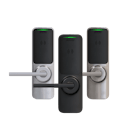Hospitals are where people go to seek treatment, recover, and address critical injuries. It is the place where doctors, nurses, and other healthcare providers devote themselves to helping people who need medical attention. In addition to this critical focus, a hospital unfortunately has to protect against unauthorized access, theft of medications or sensitive patient information, and guard against workplace violence, which affects hospitals more than other industries.
The healthcare market has a range of specific physical security requirements that make providing complete protection for a hospital challenging. Pharmacies and pharmaceutical storage areas need to remain secure against non-authorized personnel with systems in place that recognize and track which employees are entering and why. Numerous secure zones in a hospital need access control, such as quarantined areas or secure wards. All of this is complicated by the fact that healthcare facilities can be fast-paced; doctors and nurses need quick and easy access to areas during emergencies.
When dealing with an environment as complex as a hospital, it’s crucial to understand how locking mechanisms fit into — and work with — the overarching access control environment. Every business needs to do what it can to stand apart from others in the industry, and a locksmith who understands the total security needs for a healthcare institution will be better prepared to address the specific needs of this market.
How Access Fits into Healthcare Security
Whether it is in the heat of an emergency or simply going about a normal day, hospital employees need to have frictionless access to secure areas that they are authorized to enter. This fact requires identity management and access control systems that are easy to use, fast, and reliable. Various smart card readers and access control solutions, utilizing RFID, NFC, or UHF technologies, can be implemented to fit this environment. The locking mechanisms that are chosen for hospital entryways should incorporate these same aspects.
The doors that need to be protected in a hospital can vary greatly in their needs for locking mechanisms and access systems, ranging from external facing entryways to smaller cabinets that contain sensitive pharmaceuticals. These could be implemented as new areas of a hospital are constructed or they might need to be retrofitted onto current rooms to replace outdated equipment. In any case, the solutions need to work well with the hospital’s needs and current systems.
In addition to monitoring employee access rights, hospitals also need to track critical assets to ensure they haven’t been lost or stolen. This can include tracking where wheelchairs and gurneys are stored on the campus or tagging high theft-risk packages of medication like painkillers. These and other customizable applications can be accomplished through using RFID and NFC tags. The same solutions can be used to monitor the location of infants or patients at risk for wandering.
Smart card credentials and readers can handle allowing or denying access, but they are even more powerful and agile when paired with a physical access management platform. These platforms can track movements and easily change parameters around access for certain users or times of the day. The specific needs for access points, which may change over time, could impact the locking mechanism needed for one doorway or another throughout a hospital environment.
Contractors and locksmiths working with doorway mechanisms should also be cognizant of how video surveillance can be tied to access control measures. While it is not directly relevant to the locking mechanisms for various entryways, it is important to note that certain doorways can trigger recording from a nearby video camera. Administrators can have filming begin recording for every person coming through a door. The specific ways door systems are configured, such as the direction in which they open, should not obstruct camera angle or placement.
Speedy Installations
Healthcare facilities need to have as little down time as possible at their entryways to secure areas. When an access path is taken out of commission, it ideally should be for as short a time as possible. Exploring wireless locks is one way to speed up an install and cause less disruption for both doctors and patients.
Wireless locks can be implemented into doors easier and faster than their wired counterparts, which expand the areas of interruption and increase install times. Hospital employees need to be allowed quick and easy access around a hospital in order to best help their patients. Blocking or eliminating the use of a doorway, which is necessary for wired solutions that require the installation of multiple different elements, could impede many critical functions. For example, patients might have their activity or sleep upset, both of which are necessary elements of recovery. A shorter installation time with wireless locks means that work can be more easily scheduled at a convenient time for patients and doctors.
If you’re in the planning phase for a building in construction and can implement a host of locking mechanisms and security systems that work together, it is important to weigh out the advantages of wireless options compared to wired. When it comes to retrofitting new pieces of hardware onto existing doors or systems, it is crucial to keep these elements in mind, as users are increasingly demanding solutions that integrate well into their existing security measures, while causing as little disruption to daily functions as possible.
Protecting Data As Well As Physical Assets
Due to the nature of their work, healthcare centers collect and maintain many types of sensitive data. In the event of a breach, patients’ sensitive information could be maliciously accessed via a weak point in the network. Endpoint devices that have access to the network should be cybersecure against breach vulnerabilities. When many systems are interconnected, having proper cybersecurity protocols among all devices is a necessary step to ensure that all systems on a hospital’s network are running smoothly.
However, data protection is not only a cyber concern. Physical security plays a crucial role when it comes to the access of server rooms or medical files. Access control measures paired with the right locking mechanism are needed for server racks as well as any area that might have forms with sensitive patient information.
Solutions to Meet the End Goal
The goal, whether through physical locking mechanisms or electronic access control, is very similar across all applications: keeping the wrong people out while letting the right people in. This is certainly true for the hospital environment. Above and beyond, hospitals need to track and locate critical equipment or resources while also monitoring all the people entering secure areas and their reasons for doing so. These various elements of technology hinge upon one critical point: whether the door is physically locked or unlocked when it needs to be.
Healthcare facilities are focused on providing the best level of care for their patients, and that includes keeping them safe, securing their critical medications, and protecting their sensitive information. When taking into account the variety of factors administrators have to oversee, it’s natural that they want to contract individuals that know and can appreciate their unique needs.
Jason Spielfogel is Identiv Director of Product Management. For more information, visit www.identiv.com.






